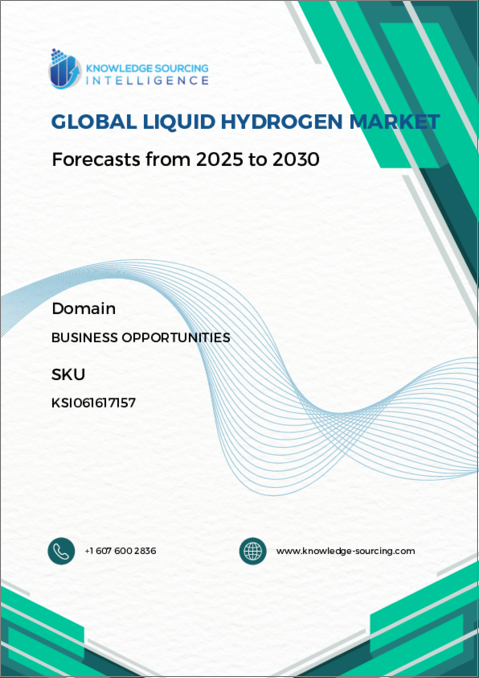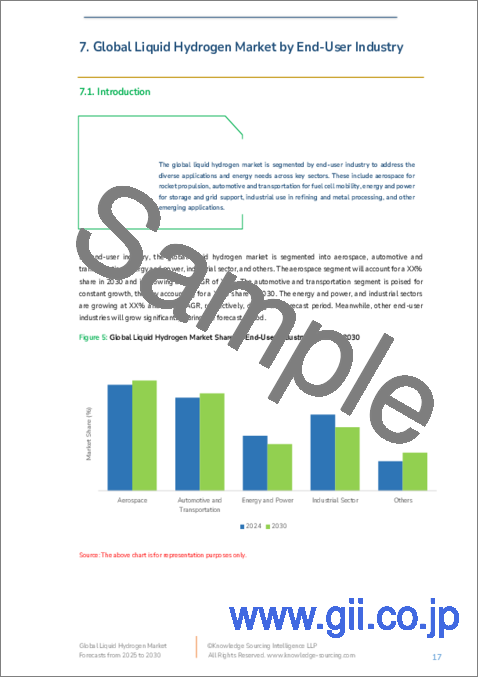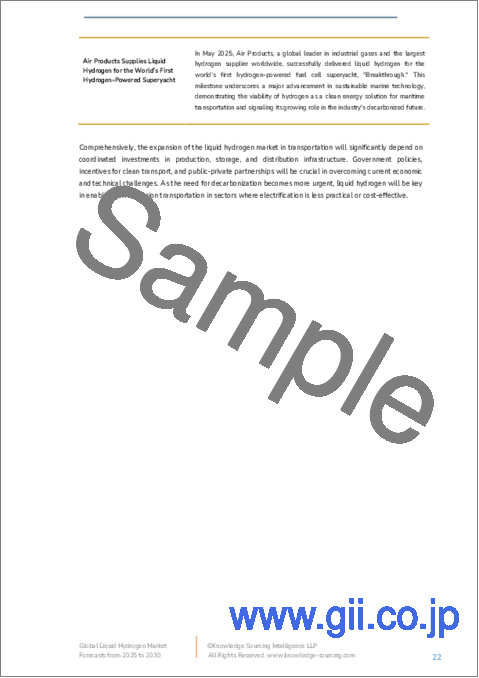|
|
市場調査レポート
商品コード
1627145
液体水素の世界市場:将来予測 (2025年~2030年)Global Liquid Hydrogen market - Forecasts from 2025 to 2030 |
||||||
カスタマイズ可能
|
|||||||
| 液体水素の世界市場:将来予測 (2025年~2030年) |
|
出版日: 2024年11月14日
発行: Knowledge Sourcing Intelligence
ページ情報: 英文 147 Pages
納期: 即日から翌営業日
|
全表示
- 概要
- 目次
液体水素市場はCAGR 7.54%で成長し、2025年の市場規模318億7,000万米ドルから2030年には458億3,000万米ドルに達すると予想されます。
液体水素 (LH2) は、水素ガスを極低温に冷却することで得られる液体状態の水素です。複数の要因が液体水素市場を牽引しています。液体水素は、主に航空宇宙、輸送、工業プロセスの燃料として使用されます。環境に優しい交通機関への需要が高まるにつれ、自動車に使用される液体水素のような革新的技術の必要性が高まると思われます。
主要企業やエネルギー企業、技術プロバイダー、産業ユーザー間の協力により、液体水素技術の開発と採用が加速しています。政府の支援や政策により、水素技術や世界の水素サプライチェーンの適応も進んでいます。
EUは2020年に水素に関する戦略 (COM/2020/301) を採択し、投資支援、生産と需要の支援、水素市場とインフラの構築、調査と協力、国際協力の5つの分野で政策的行動指針を示しました。EUは、2030年までに1,000万トンの水素を製造し、1,000万トンを輸入する再生可能水素の開発を計画しています。
液体水素市場の促進要因
- 宇宙探査用液体水素の需要拡大
液体水素は、ロケット燃料として数十年にわたり宇宙ミッションに使用されてきました。液体水素はエネルギー密度が高く、燃焼効率が高いため、宇宙船の動力源として理想的です。
NASAは、ロケットを宇宙へ推進するために液体水素を利用してきました。NASAのSLSロケットの燃料補給をサポートするため、ケネディのEGSプログラムはパッド39Bに液体水素貯蔵タンクを建設しました。SLSのコアステージとインスペースステージは、4つのコアステージと1つの上段エンジンに燃料を供給するために、73万ガロンの液体水素と液体酸素を必要としました。インド、中国、アラブ首長国連邦、サウジアラビアなど、さまざまな国による宇宙開発計画の増加は、液体水素のような大量の宇宙燃料の需要につながっています。
液体水素市場の地理的展望:
- 世界の液体水素市場は5地域に区分されます。
地域別に見ると、液体水素市場は北米、南米、欧州、中東・アフリカ、アジア太平洋に区分されます。アジア太平洋地域は、中国、日本、インド、韓国などの主要経済国が支配的です。急成長している新興国の中には、ASEAN諸国などこの地域のものもあります。
アジア太平洋地域は、金属の精錬から肥料用アンモニアの生産まで、さまざまな工業プロセスでの用途が増加しているため、液体水素市場で最も速い成長が見込まれています。北米は、水素自動車の普及により、液体水素市場で大きなシェアを占めると予想されます。
当レポートを購入する理由
- 洞察に満ちた分析:顧客セグメント、政府政策と社会経済要因、消費者の嗜好、産業別、その他のサブセグメントに焦点を当て、主要地域だけでなく新興地域もカバーする詳細な市場考察を得ることができます。
- 競合情勢:世界の主要企業が採用している戦略的作戦を理解し、適切な戦略による市場浸透の可能性を理解することができます。
- 市場促進要因と将来動向:ダイナミックな要因と極めて重要な市場動向、そしてそれらが今後の市場展開をどのように形成していくかを探ります。
- 行動可能な提言:ダイナミックな環境の中で、新たなビジネスストリームと収益を発掘するための戦略的意思決定に洞察を活用します。
- 幅広い利用者に対応:新興企業、研究機関、コンサルタント、中小企業、大企業にとって有益で費用対効果が高いです。
どのような用途で利用されていますか?
業界・市場考察、事業機会評価、製品需要予測、市場参入戦略、地理的拡大、設備投資決定、規制の枠組みと影響、新製品開発、競合の影響
分析範囲
- 過去のデータと予測 (2022~2030年)
- 成長機会、課題、サプライチェーンの展望、規制枠組み、顧客行動、動向分析
- 競合企業のポジショニング・戦略・市場シェア分析
- 収益成長率と予測分析:セグメント別・地域別 (国別)
- 企業プロファイリング (戦略、製品、財務情報、主な動向など)
目次
第1章 イントロダクション
- 市場概要
- 市場の定義
- 分析範囲
- 市場セグメンテーション
- 通貨
- 前提条件
- 基準年と予測年のタイムライン
- ステークホルダーにとっての主なメリット
第2章 分析手法
- 分析デザイン
- 分析プロセス
第3章 エグゼクティブサマリー
- 主な調査結果
- アナリストの見解
第4章 市場力学
- 市場促進要因
- 宇宙探査における液体水素の需要増加
- 商用車における水素燃料電池の採用増加
- 投資とイノベーションの増加
- 市場抑制要因
- 取り扱いと保管にかかるコストの高さ
- ポーターのファイブフォース分析
- 業界バリューチェーン分析
第5章 世界の液体水素市場:最終用途産業別
- イントロダクション
- 航空宇宙
- 自動車・輸送
- エネルギー・電力
- 産業部門
- その他
第6章 世界の液体水素市場:流通別
- イントロダクション
- パイプライン
- 極低温タンク
- その他
第7章 世界の液体水素市場:地域別
- 世界概要
- 北米
- 米国
- カナダ
- メキシコ
- 南米
- ブラジル
- アルゼンチン
- その他南米
- 欧州
- 英国
- ドイツ
- フランス
- イタリア
- スペイン
- その他欧州地域
- 中東・アフリカ
- サウジアラビア
- アラブ首長国連邦
- その他中東・アフリカ
- アジア太平洋
- 中国
- インド
- 日本
- 韓国
- 台湾
- タイ
- インドネシア
- その他アジア太平洋地域
第8章 競合環境と分析
- 主要企業と戦略分析
- 市場シェア分析
- 企業合併・買収 (M&A)、合意、事業協力
- 競合ダッシュボード
第9章 企業プロファイル
- Air Liquide
- Air Products and Chemicals, Inc.
- Iwatani Corporation
- Linde PLC
- Messer Group GMBH
- Nippon Sanso Holdings Corporation
- Cryolor
- Hylium Industries, Inc.
- Demaco
- INOX India Limited
- Plug Power Inc.
The global liquid hydrogen market is expected to grow at a CAGR of 7.54%, reaching a market size of US$45.83 billion in 2030 from US$31.87 billion in 2025.
Liquid hydrogen (LH2) is hydrogen in its liquid state, achieved by cooling hydrogen gas to extremely low temperatures. Multiple factors have driven the market for liquid hydrogen. It is used primarily as a fuel in aerospace, transportation, and industrial processes. With the growing demand for green transportation, the need for innovative technologies like liquid hydrogen used in the vehicle would rise.
Collaborations between key players, energy companies, technology providers, and industrial users are accelerating the development and adoption of liquid hydrogen technologies. The adaptation of hydrogen technologies and global hydrogen supply chains has also been increasing due to government support and policies.
The EU adopted a strategy on hydrogen (COM/2020/301) in 2020 and policy action points in 5 areas: investment support, support production and demand, creating a hydrogen market and infrastructure, research and cooperation, and international cooperation. The EU planned to develop renewable hydrogen to produce 10 million tonnes and import 10 million tonnes by 2030.
Global liquid hydrogen market drivers
- Growing demand for liquid hydrogen for space exploration
Liquid hydrogen has been used in space missions for decades as rocket fuel. It has a high energy density and efficient combustion, making it ideal for powering spacecraft.
NASA has relied on liquid hydrogen to propel its rockets into space. To support the fueling of NASA's SLS rocket, Kennedy's EGS Program built the liquid hydrogen storage tank at Pad 39B. The SLS core stage and in-space stage required 730,000 gallons of liquid hydrogen and liquid oxygen to fuel the four-core stage and single upper-stage engine. The growing space programs from different nations like India, China, UAE, Saudi Arabia, etc., are leading to the demand for space fuel in large quantities like liquid hydrogen.
Geographical outlooks of the global liquid hydrogen market:
- The global liquid hydrogen market is segmented into five regions worldwide
By geography, the global liquid hydrogen market is segmented into North America, South America, Europe, the Middle East and Africa, and Asia Pacific. The major economies like China, Japan, India, and South Korea dominate the Asia-Pacific region. Some of the fastest-growing emerging economies are from this region, such as ASEAN countries.
The Asia Pacific region is expected to see the fastest growth in the global liquid hydrogen market due to increasing applications in various industrial processes, from refining metals to producing ammonia for fertilizers. North America is expected to have a significant global liquid hydrogen market share due to hydrogen-powered vehicles becoming more common.
Reasons for buying this report:-
- Insightful Analysis: Gain detailed market insights covering major as well as emerging geographical regions, focusing on customer segments, government policies and socio-economic factors, consumer preferences, industry verticals, other sub- segments.
- Competitive Landscape: Understand the strategic maneuvers employed by key players globally to understand possible market penetration with the correct strategy.
- Market Drivers & Future Trends: Explore the dynamic factors and pivotal market trends and how they will shape up future market developments.
- Actionable Recommendations: Utilize the insights to exercise strategic decision to uncover new business streams and revenues in a dynamic environment.
- Caters to a Wide Audience: Beneficial and cost-effective for startups, research institutions, consultants, SMEs, and large enterprises.
What do businesses use our reports for?
Industry and Market Insights, Opportunity Assessment, Product Demand Forecasting, Market Entry Strategy, Geographical Expansion, Capital Investment Decisions, Regulatory Framework & Implications, New Product Development, Competitive Intelligence
Report Coverage:
- Historical data & forecasts from 2022 to 2030
- Growth Opportunities, Challenges, Supply Chain Outlook, Regulatory Framework, Customer Behaviour, and Trend Analysis
- Competitive Positioning, Strategies, and Market Share Analysis
- Revenue Growth and Forecast Assessment of segments and regions including countries
- Company Profiling (Strategies, Products, Financial Information, and Key Developments among others)
The global liquid hydrogen market is segmented and analyzed as follows:
By End Use Industry
- Aerospace
- Automotive and Transportation
- Energy and Power
- Industrial Sector
- Others
By Distribution
- Pipelines
- Cryogenic Tanks
- Others
By Geography
- North America
- USA
- Canada
- Mexico
- South America
- Brazil
- Argentina
- Rest of South America
- Europe
- United Kingdom
- Germany
- France
- Italy
- Spain
- Rest of Europe
- Middle East and Africa
- Saudi Arabia
- UAE
- Rest of the Middle East and Africa
- Asia Pacific
- China
- India
- Japan
- South Korea
- Taiwan
- Thailand
- Indonesia
- Rest of Asia-Pacific
TABLE OF CONTENTS
1. INTRODUCTION
- 1.1. Market Overview
- 1.2. Market Definition
- 1.3. Scope of the Study
- 1.4. Market Segmentation
- 1.5. Currency
- 1.6. Assumptions
- 1.7. Base and Forecast Years Timeline
- 1.8. Key benefits for the stakeholders
2. RESEARCH METHODOLOGY
- 2.1. Research Design
- 2.2. Research Process
3. EXECUTIVE SUMMARY
- 3.1. Key Findings
- 3.2. Analyst View
4. MARKET DYNAMICS
- 4.1. Market Drivers
- 4.1.1. Growing demand for liquid hydrogen for space exploration
- 4.1.2. Increasing adoption of hydrogen fuel cells in commercial vehicle
- 4.1.3. Rising investments and innovations
- 4.2. Market Restraints
- 4.2.1. High cost of handling and storage
- 4.3. Porter's Five Forces Analysis
- 4.3.1. Bargaining Power of Suppliers
- 4.3.2. Bargaining Power of Buyers
- 4.3.3. The Threat of New Entrants
- 4.3.4. Threat of Substitutes
- 4.3.5. Competitive Rivalry in the Industry
- 4.4. Industry Value Chain Analysis
5. GLOBAL LIQUID HYDROGEN MARKET BY END-USE INDUSTRY (2022 TO 2030) (US$ BILLION)
- 5.1. Introduction
- 5.2. Aerospace
- 5.3. Automotive and Transportation
- 5.4. Energy and Power
- 5.5. Industrial Sector
- 5.6. Others
6. GLOBAL LIQUID HYDROGEN MARKET BY DISTRIBUTION (2022 TO 2030) (US$ BILLION)
- 6.1. Introduction
- 6.2. Pipelines
- 6.3. Cryogenic Tanks
- 6.4. Others
7. GLOBAL LIQUID HYDROGEN MARKET BY GEOGRAPHY (2022 TO 2030) (US$ BILLION)
- 7.1. Global Overview
- 7.2. North America
- 7.2.1. United States
- 7.2.2. Canada
- 7.2.3. Mexico
- 7.3. South America
- 7.3.1. Brazil
- 7.3.2. Argentina
- 7.3.3. Rest of South America
- 7.4. Europe
- 7.4.1. United Kingdom
- 7.4.2. Germany
- 7.4.3. France
- 7.4.4. Italy
- 7.4.5. Spain
- 7.4.6. Rest of Europe
- 7.5. Middle East and Africa
- 7.5.1. Saudi Arabia
- 7.5.2. United Arab Emirates
- 7.5.3. Rest of the Middle East and Africa
- 7.6. Asia-Pacific
- 7.6.1. China
- 7.6.2. India
- 7.6.3. Japan
- 7.6.4. South Korea
- 7.6.5. Taiwan
- 7.6.6. Thailand
- 7.6.7. Indonesia
- 7.6.8. Rest of Asia-Pacific
8. COMPETITIVE ENVIRONMENT AND ANALYSIS
- 8.1. Major Players and Strategy Analysis
- 8.2. Market Share Analysis
- 8.3. Mergers, Acquisitions, Agreements, and Collaborations
- 8.4. Competitive Dashboard
9. COMPANY PROFILES
- 9.1. Air Liquide
- 9.2. Air Products and Chemicals, Inc.
- 9.3. Iwatani Corporation
- 9.4. Linde PLC
- 9.5. Messer Group GMBH
- 9.6. Nippon Sanso Holdings Corporation
- 9.7. Cryolor
- 9.8. Hylium Industries, Inc.
- 9.9. Demaco
- 9.10. INOX India Limited
- 9.11. Plug Power Inc.






